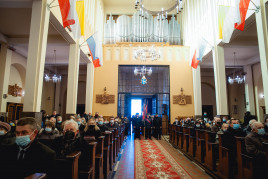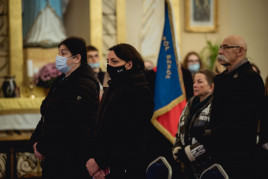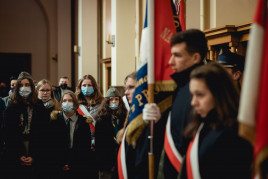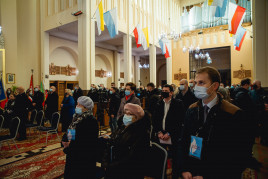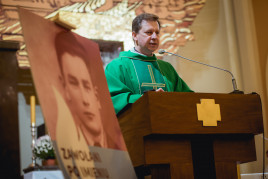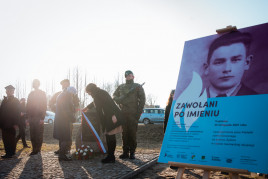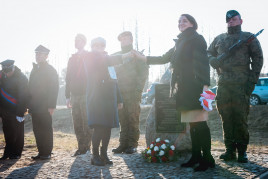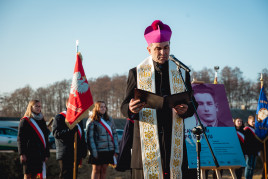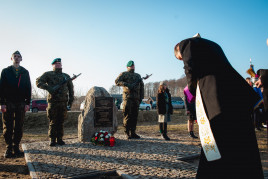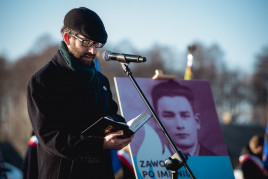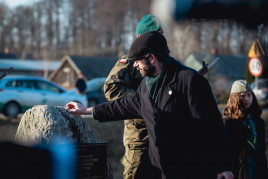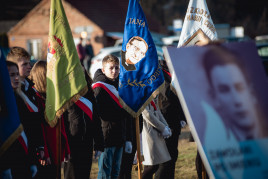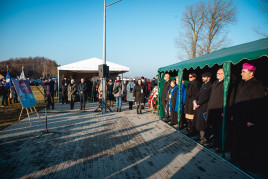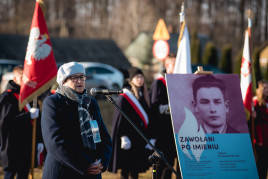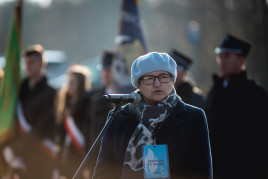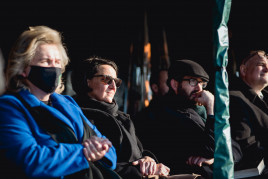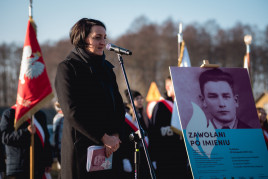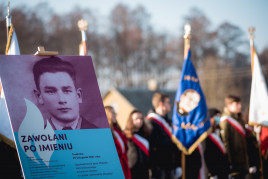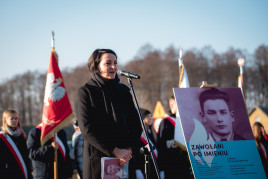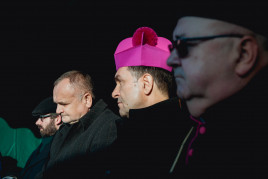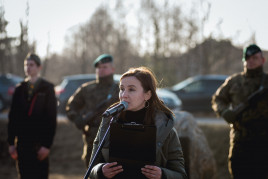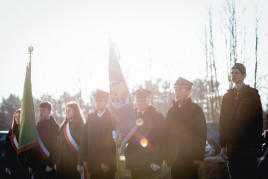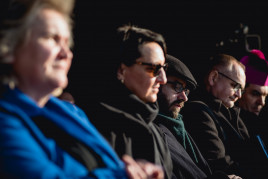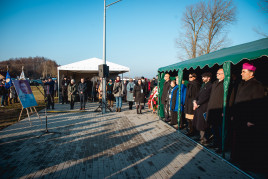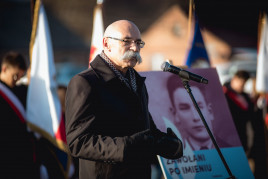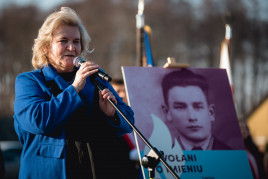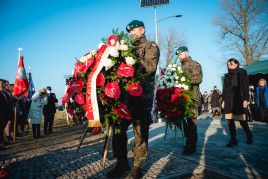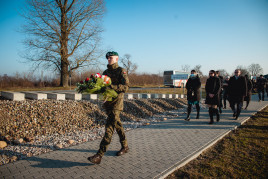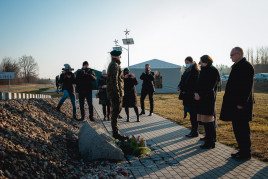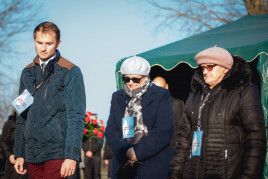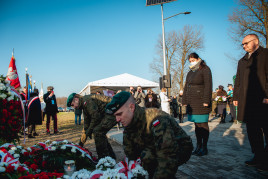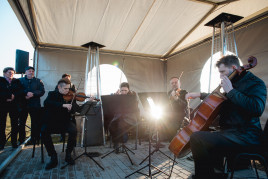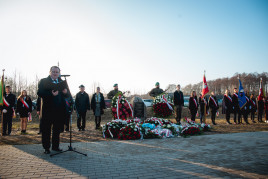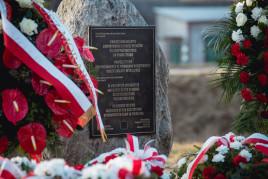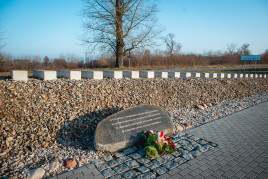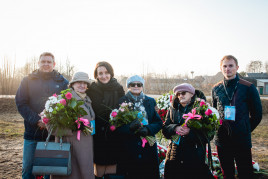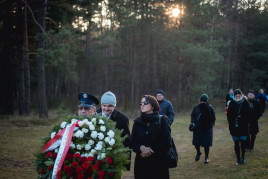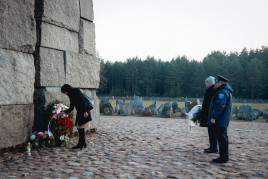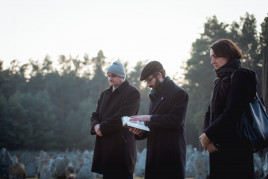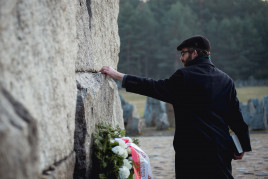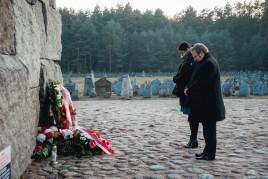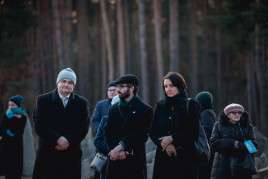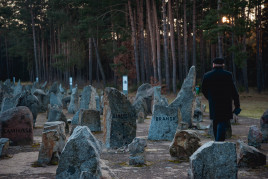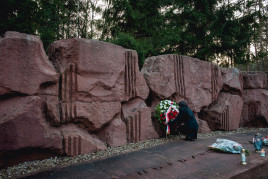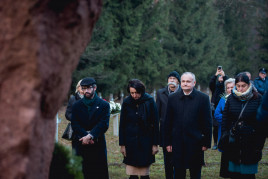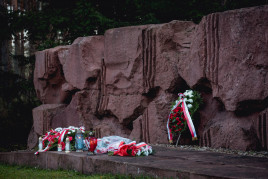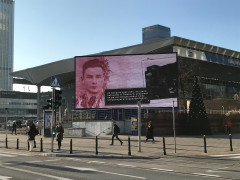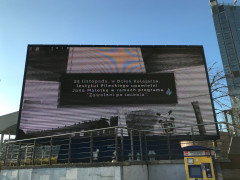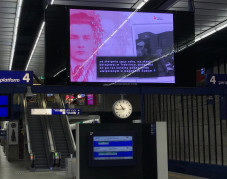Jan Maletka commemorated in the village of Treblinka - Instytut Pileckiego
Jan Maletka commemorated in the village of Treblinka
On 25 November, Railway Workers’ Day, the Pilecki Institute commemorated Jan Maletka in the village of Treblinka. The date was not chosen without reason: the victim worked on the railway, and was murdered for giving water to Jews being transported into the death camp.
Railroad workers gave water to Jews even though it broke the rules. Even the wives of station workers [...] cried and ran with buckets to the wagons to give at least a drop of water to the small children. [...] A road service worker was shot for giving water at Treblinka station. I don’t remember his name.
Excerpt from Wspomnienia dawne i nowe [“Memories old and new”] by Franciszek Ząbecki.
In addition to Bełżec and Sobibór, the German Nazi death camp of Treblinka II was one of three centers of mass extermination established to liquidate Jews from the General Government and the Białystok District. It is estimated that approximately 900,000 Jews were murdered during the period of its operation from July 1942 to November 1943. Despite the fact that the German occupier introduced the death penalty for helping Jews, railway workers from the station at Treblinka, as well as from other stations along the lines, provided assistance to people packed into the freight wagons. During the brief stopovers, they opened doors and provided tools, thus enabling attempts to escape. They also gave water to the thirsty Jews.
Jan Maletka (21 years old), his brother Stanisław (22), and their friend Remigiusz Pawłowicz (20), from Mińsk Mazowiecki, were resettled by the German authorities in Małkinia and employed as railway workers. They lived in worker wagons near the gravel pit in Treblinka. Among other duties, they worked “on the tracks” whenever they were needed and operated trains transporting construction aggregate from the gravel pit. After work, they spent their free time together. The young men found their chosen partners in Małkinia, and Jan even had a date set for their wedding.

“Jan, Stanisław and Remigiusz were carrying out their assigned work at Treblinka station when yet another transport of Jews (likely from the Warsaw Ghetto) arrived on 20 August 1942. At around 10 a.m., they carefully made their way toward the wagons, carrying containers of water. They were unexpectedly spotted by one of the guards on duty, who immediately opened fire with his automatic weapon. Jan Maletka was killed on site. Stanisław and Remigiusz were able to fall to the ground and find cover in a nearby ditch. They managed to flee. As it later turned out, they had not been recognized by the staff of the camp,” said Dr. Marcin Panecki, a historian from the Pilecki Institute.
The Germans intended to transport Jan’s body into the camp and bury it there. Stanisław and Remigiusz turned to Treblinka’s railwaymen for help and, at their insistence, the Germans abandoned their plans and allowed the two men to take the body away. Stanisław and Remigiusz buried Jan in the cemetery in Prostyń. A grave was dug in the earth and a wooden cross was erected, but they did not stand the test of time. The exact final resting place of Jan Maletka remains unknown.
After these tragic events, Stanisław and Remigiusz returned to work on the railway for a brief period. Remigiusz Pawłowicz never forgot his friend, and told his daughter Barbara about him many years later.
On 25 November, Railway Workers’ Day, the Pilecki Institute commemorated Jan Maletka. The event, which represented the culmination of that year’s edition of the “Called By Name” project, was a particular one, highlighted by the cooperation with the PKP Group and the Treblinka Museum, and by the participation of Catholic priests and a rabbi.
The ceremony began with Holy Mass at the St. Anne Sanctuary of the Holy Trinity in Prostyń, celebrated by Rev. Bishop Piotr Sawczuk, Rev. Dr. Paweł Rytel-Adrianik, Rev. Józef Poskrobko, Rev. Jan Marek Wróblewski, Rev. Piotr Legacki, and Rev. Krzysztof Maksimiuk.
A stone with a plaque commemorating Jan Maletka was erected in the village of Treblinka, where there is also an installation commemorating Jews at the site of the former railway station. The plaque was unveiled jointly by Zofia Łopacka, Jan Maletka’s niece, and Prof. Magdalena Gawin, Deputy Minister of Culture and National Heritage and initiator of the project. The site was consecrated by Bishop Piotr Sawczuk. Rabbi Yehoshua Ellis said a prayer for the deceased on behalf of the Jewish community.
“Jan’s nature and joyfulness really reminded me of his father, my grandfather, who lived to be 86. Jan was the life of the party, he was very kind and open-hearted. He was always optimistic about life and people, even in spite of the war. So much so that it is difficult to believe his life was ended so suddenly. Asked why they were doing what they were, Jan apparently told his future mother-in-law: ‘It’s impossible to remain indifferent when you hear that awful screaming,’” said Zofia Łopacka, Jan Maletka’s niece.
“This is such a special place, marked by the suffering of thousands of innocent people, that we must all work to ensure that some good comes from that young man’s misfortune and sacrifice. Good must always prevail,” said the Deputy Minister of Culture and National Heritage Magdalena Gawin, initiator of the “Called By Name” project.
The director of the Pilecki Institute, Dr. Wojciech Kozłowski, addressed a letter to be read out at the ceremony by Dr. Anna Stróż-Pawłowska, head of the institute’s “Called By Name” Department: “It is difficult to remain indifferent to this tragedy. It is difficult not to ask what cruelty was required to establish a whole criminal system that rewarded acts of mercy with death – what courage and moral stalwartness was needed to resist evil and remain human in such inhuman times, even at the cost of one’s own life.”
The ceremony, co-organized by the PKP Group, the Treblinka Museum, the district of Ostrów Mazowiecka (represented by the starost Zbigniew Chrupka) and the commune of Małkinia Górna (represented by the head of the commune Bożena Kordek), was also attended by representatives of the family of the victim, Anna Gutkowska – deputy director of the Pilecki Institute, Dr. Edward Kopówka –director of the Treblinka Museum, representatives of the PKP Group, representatives of the government and local authorities, and the local community.
After the official proceedings of the commemoration, members of Jan Maletka’s family, Deputy Minister Prof. Magdalena Gawin, Deputy Director of the Pilecki Institute Anna Gutkowska, Rabbi Yehoshua Ellis, and representatives of local authorities laid flowers and lit candles at the site of the Treblinka I labor camp and the Treblinka II death camp.
The event was given a special setting with the help of the PKP Group. The signal to start the ceremony was given at 12:30 p.m. by trains passing nearby the site. An animation presenting the story of Jan Maletka was displayed on advertising screens near the Central Station in Warsaw and on its platforms throughout the day.
The commemoration was accompanied by educational workshops organized by the employees of the Pilecki Institute and the Pilecki Family Museum in Ostrów Mazowiecka in nearly 20 primary and secondary schools in the region.


